Privacy-aware Access Control Part 1
Outline
- Privacy-aware Access Control
- Hippocratic Databases (Agrawal, 2002)
- Purpose-based Access Control (Byun and Li, 2008)
- Enterprise Privacy Authorization Language (IBM 2003)
Privacy-aware Access Control
Privacy
Privacy is an important issue today
- Individuals wants
- Information about them protected
- Enterprises need to
- Keep their customers feel safe
- Obey legal regulations
- Protect themselves from any legal dispute
- Maintain good reputations
Privacy Regulations
Impose stringent requirements on the collection, processing and disclosure of personal data
- Fair and lawful processing
- Purpose specification
- Consent
- Minimality
- Minimal disclosure
- Information quality
- Data subject’s control
- Sensitivity
- Information security
Purpose Specification: Personal data should be collected for specified, lawful and legitimate purposes and not processed in ways that are incompatible with the purposes for which data have been collected.
Beyond Access Control
Traditional access controls focus on which users perform which actions on which data objects
Privacy is more than confidentiality and integrity of data
Privacy policies are concerned with which data object is used for which purposes
“We will collect and use customer identifiable information for billing purposes and to anticipate and resolve problems with your service.”
Notion of purpose must play a major role in access control: Access decisions should be made based on purpose
Privacy Policy
- Who: user identities or roles
- What: resources or data
- How: actions
- Why: the reason for which data are processed
- Conditions: under which the access is granted/denied
- Obligations: mandatory requirements to be fulfilled
Example
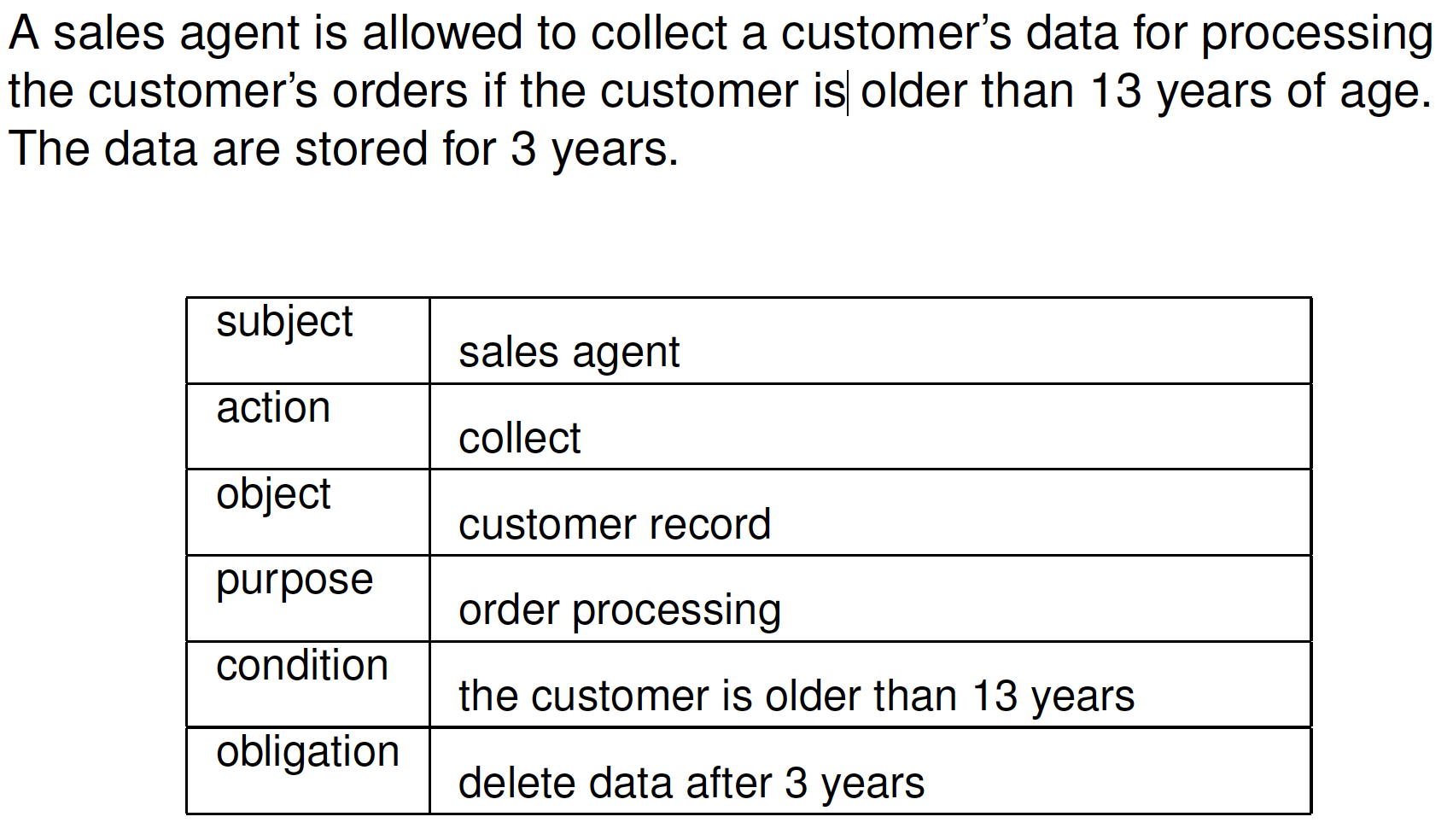
Access control
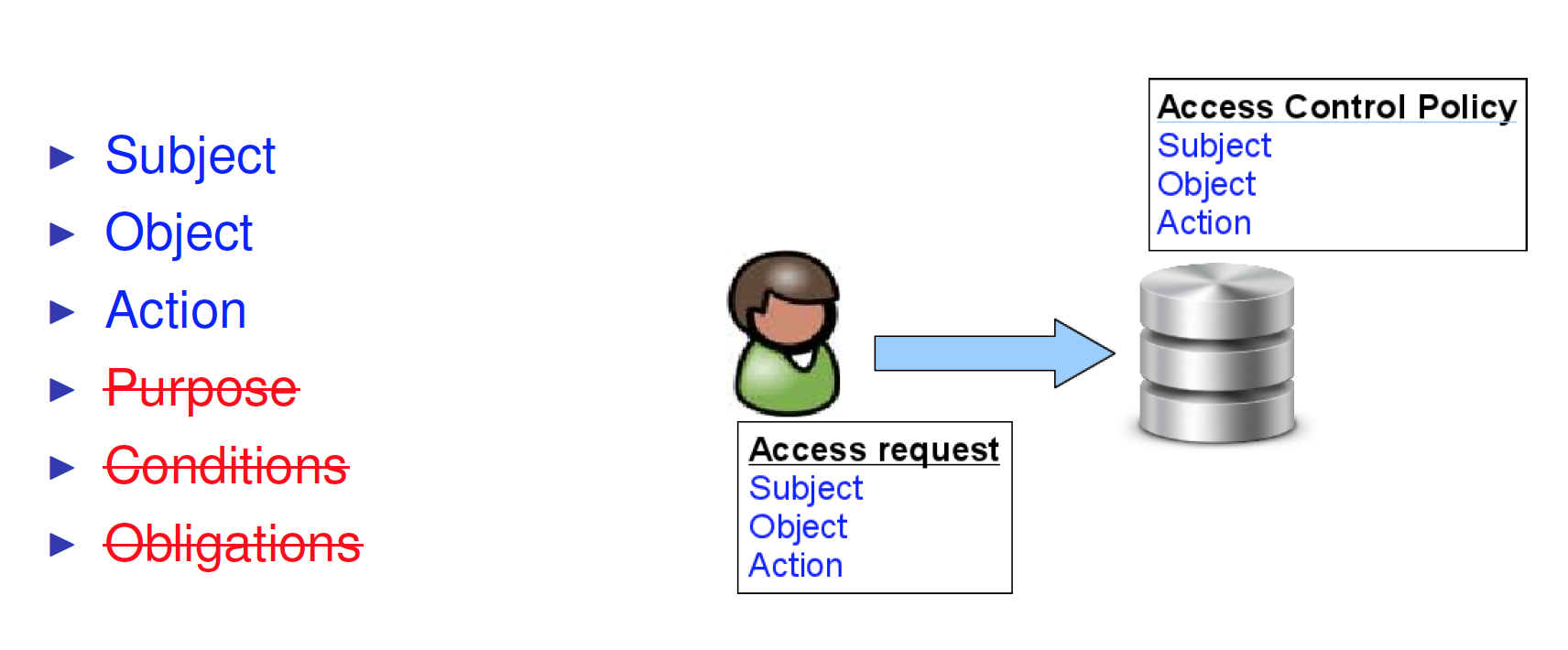
Usage control
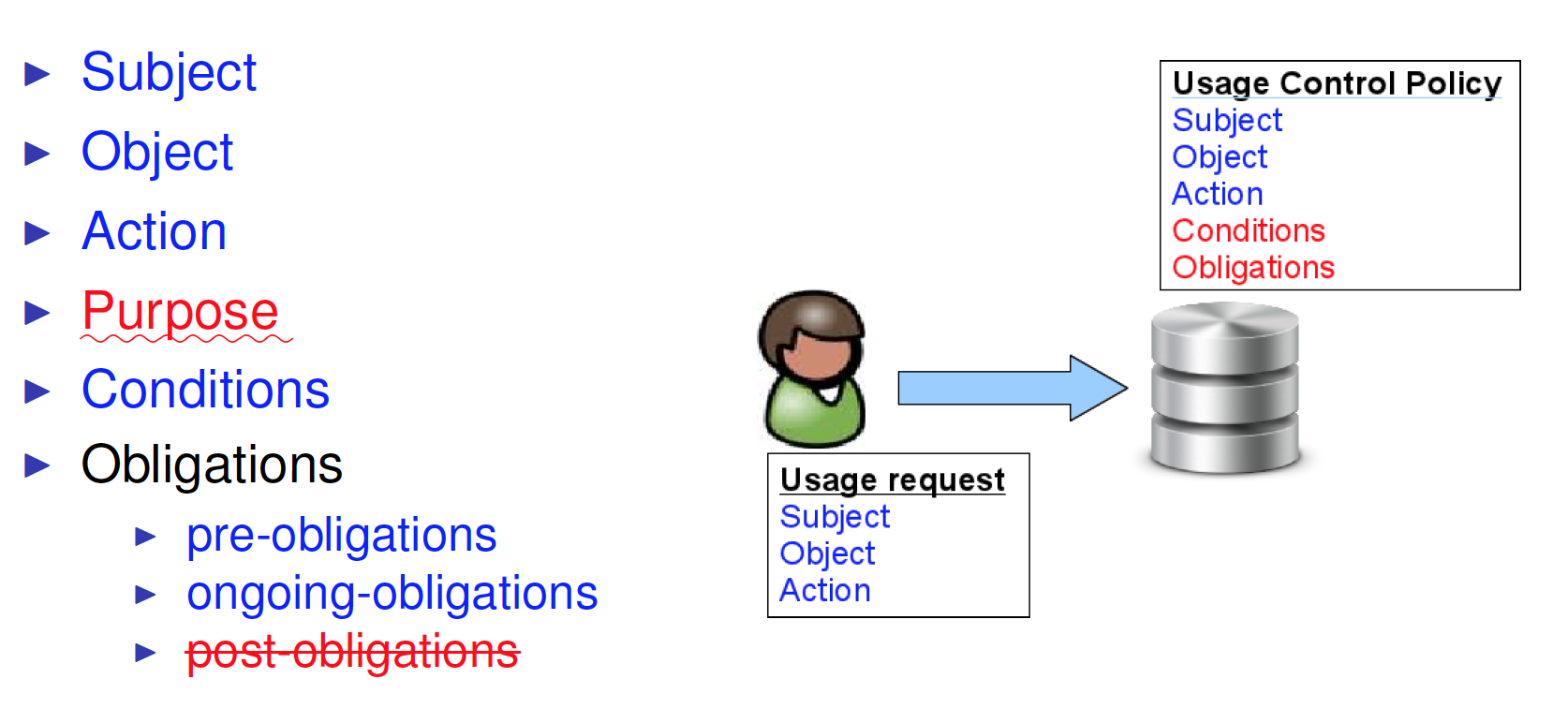
Privacy-Aware Access Control
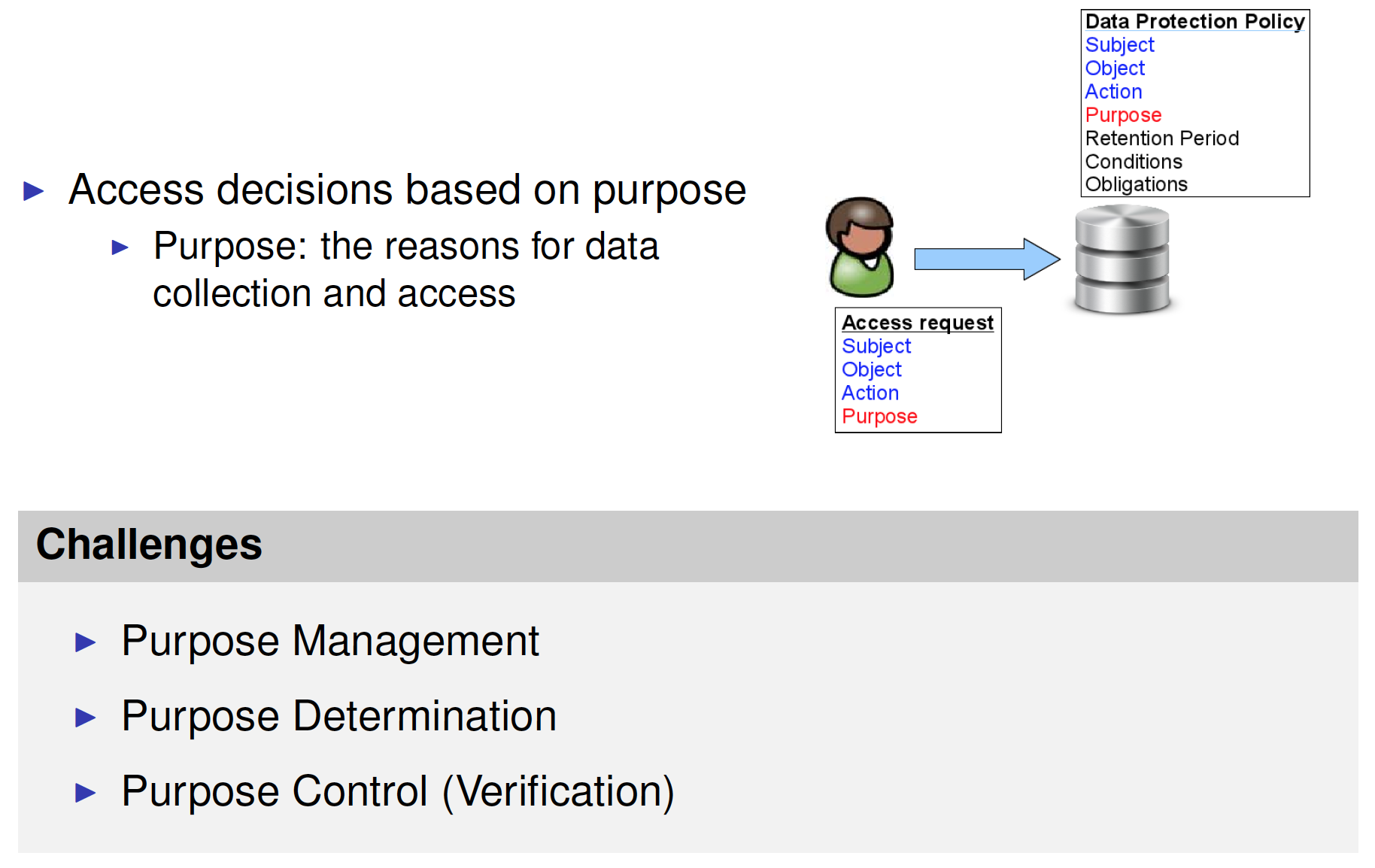
Hippocratic Databases
Goal: Incorporate privacy protection within DB systems
Inspired by the Hippocratic Oath
“And about whatever I may see or hear in treatment, or even without treatment, in the life of human beings – things that should not ever be blurted out outside – I will remain silent, holding such things to be unutterable.”
Establish a number of guiding principles
Encompass an architecture that uses privacy metadata
Use purpose as the central concept
The 10 Principles
Purpose Specification. For personal information stored in the database, the purposes for which the information has been collected shall be associated with the information.
Consent. The purposes associated with personal information shall have the consent of the data subject.
Limited Collection. The personal information shall be limited to the minimum necessary for accomplishing the specified purposes.
Limited Use. The database shall run only those queries that are consistent with the purposes for which the information has been collected.
Limited Disclosure. The personal information stored in the database shall not be communicated outside the database for purposes other than those for which there is consent from the data subject.
Limited Retention. Personal information shall be retained only as long as necessary for the fulfillment of the purposes for which it has been collected.
Accuracy. Personal information stored in the database shall be accurate and up-to-date.
Safety. Personal information shall be protected by security safeguards against theft and other misappropriations.
Openness. A data subject shall be able to access all her information stored in the database.
Compliance. A data subject shall be able to verify compliance with the above principles. Similarly, the database shall be able to address a challenge concerning compliance.
- 目的定义(Purpose Specification ):对收集和存储在数据库中的每一条个人信息都应该给出相应的目的描述。
- 提供者同意(Consent):每一条个人信息的相应目的都应该获得提供者的同意。
- 收集限制(Limited Collection):对个人信息的收集应该限制在满足相应目的最小需求内。
- 使用限制(Limited Use):数据库仅运行与收集信息的目的相一致的查询。
- 泄漏限制(Limited Disclosure):存储在数据库中数据不允许与外界进行与信息提供者同意的目的不符的交流。
- 保留限制(Limited Retention):个人信息只有为完成必要目的的时候才加以保留。
- 准确(Accuracy):存储在数据库中的个人信息必须是准确的,并且是最新的。
- 安全(Safety):个人信息有安全措施保护,以防被盗或挪作他用。
- 开放(Openness):信息拥有者应该能够访问自己存储在数据库中的所有信息。
- 遵从(Compliance):信息拥有者能够验证以上规则的遵从情况,相应地,数据库也应该重视对规则的挑战。具有隐私保护功能的数据库系统能够在保证系统安全性的前提下,有效提高系统的可用性。
Privacy Metadata
Purpose associated to each piece of information
For each piece of information collected for that purpose:
- Authorized-users: users who can access this information
- External-recipients: whom the information can be disclosed to
- Retention-period: how long the information is stored
Privacy-policies table: privacy practices
Privacy-authorization table: access control supporting privacy policy
| table | attributes |
|---|---|
| privacy-policies | purpose, table, attribute, {external-recipients}, retention |
| privacy-authorizations | purpose, table, attribute, {authorized-users} |
Privacy-policies table
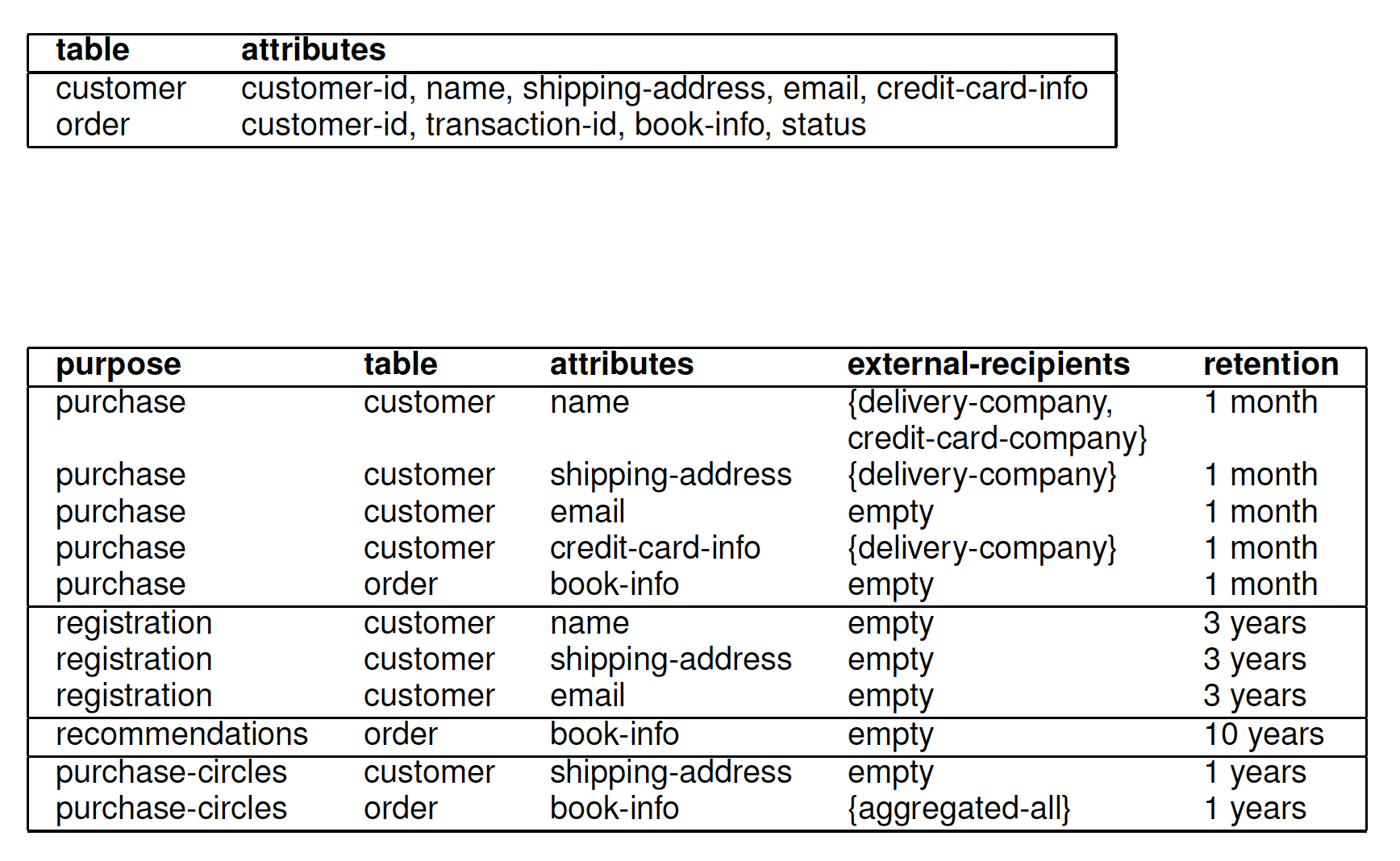
Privacy-authorization table
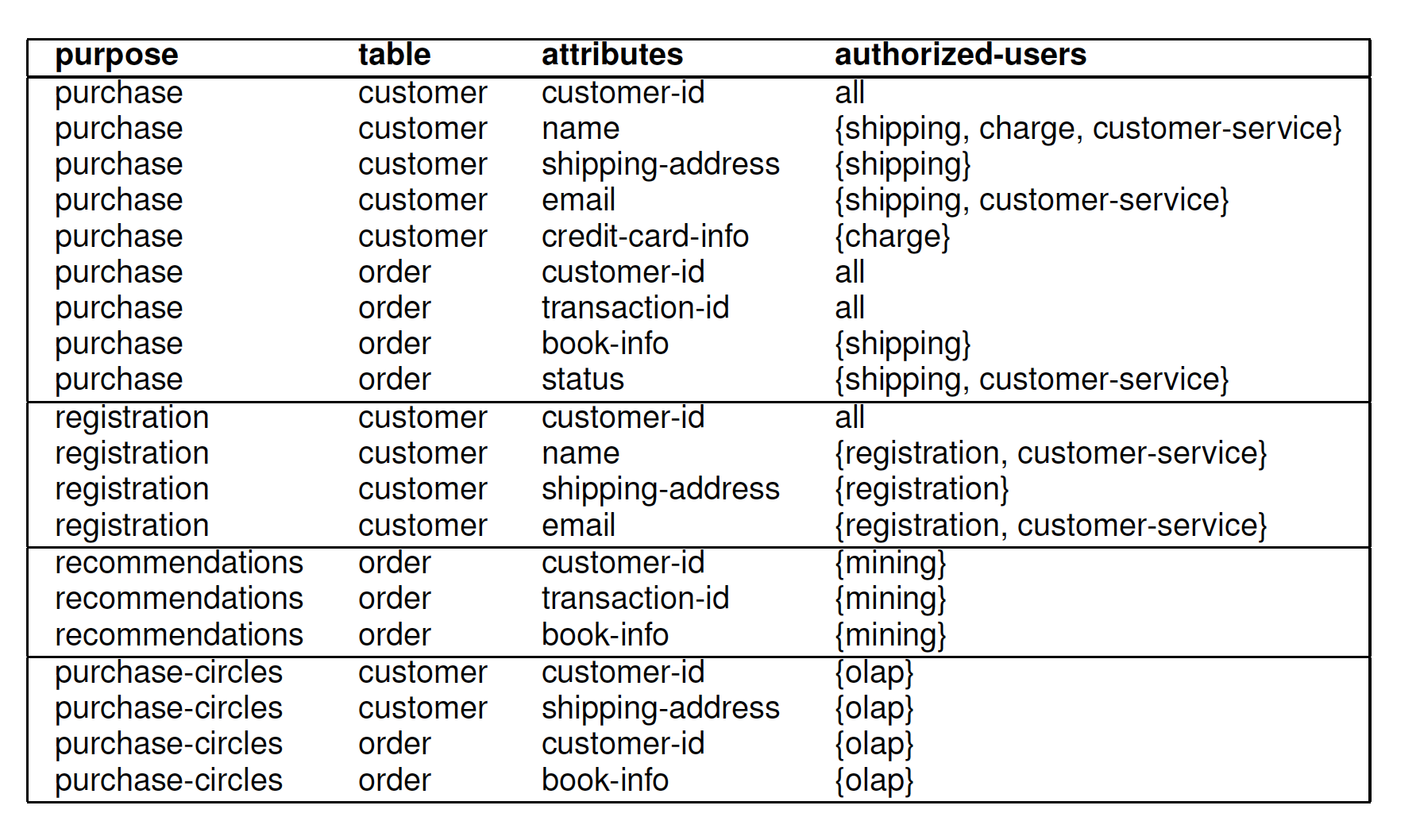
Data Collection
Matching privacy policy with user preferences
- check whether the privacy policy is acceptable to the user
- if not, database rejects the transaction
Data insertion
- Data inserted with the purpose for which it may be used
Data Processing
Queries submitted to the database along with their purpose(e.g. SELECT name FROM customer FOR Marketing)
Before query execution: check privacy-authorizations table for a match on purpose, attribute and user
During query execution: ensure that only records whose purpose attribute includes the query’s purpose will be visible to the query
Purpose Management
Difficult policy refinement (Minimality)
- Decompose purposes into sub-purposes and store them in DB
- No logical relation between purposes
Information relevant and complete wrt purpose? (Information Quality)
- Purpose P decomposed in P1 and P2 (both needed to fulfill P)
- Customer allows P1, but not P2
- Cannot specify alternatives
Purpose-based Access Control
Definition of Purpose
Describe the reason(s) for data collection and processing
Organized in a tree structure
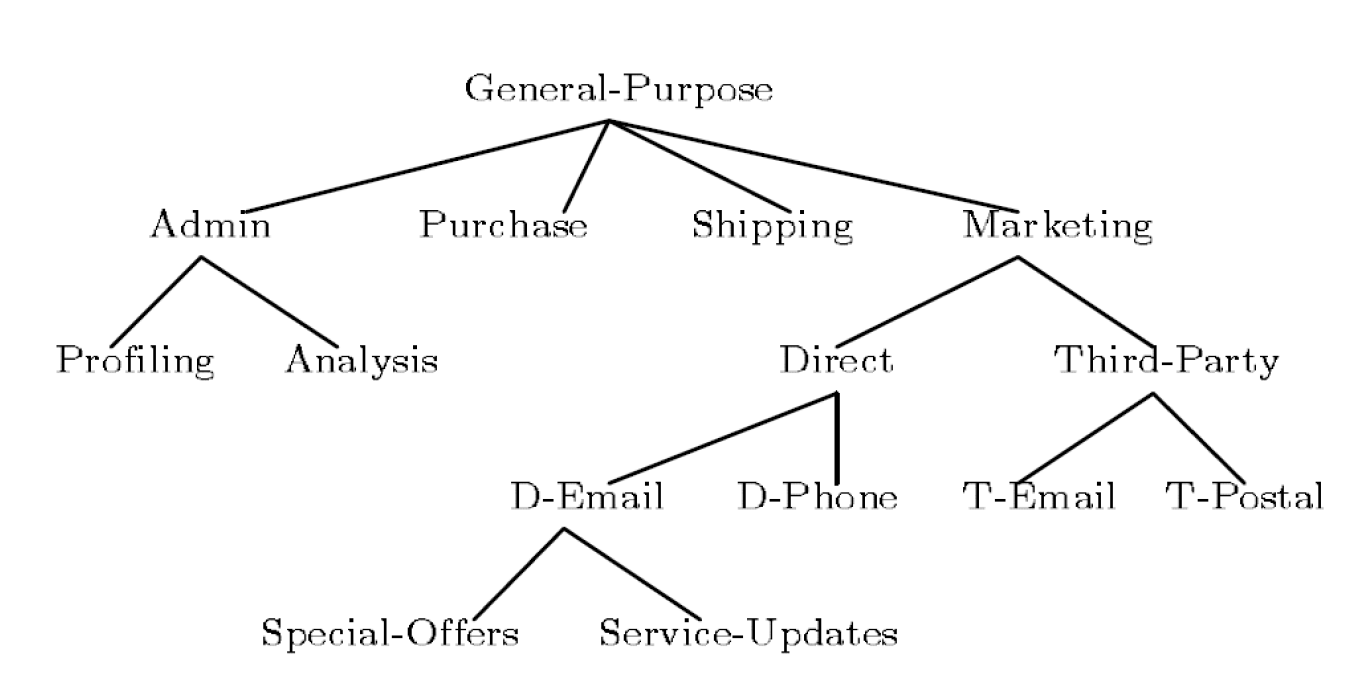
- Intended Purpose (IP)
- Regulate access to data
- Associated with data
- Access Purpose (AP)
- Purpose for accessing a particular data item
- Associated with access requests
Intended Purpose(IP)
Associated with data and regulate data processing
IP = < AIP, PIP >
- AIP – Allowed Intended Purposes
- Data access for purposes in AIP is allowed
- Translation of user preferences
- PIP – Prohibited Intended Purposes
- Data access for purposes in PIP is never allowed
- Restriction by organizational requirements or privacy laws
Ancestors and descendants
Given a set of purposes P
祖先 & 后裔

Intended Purpose – Entailment
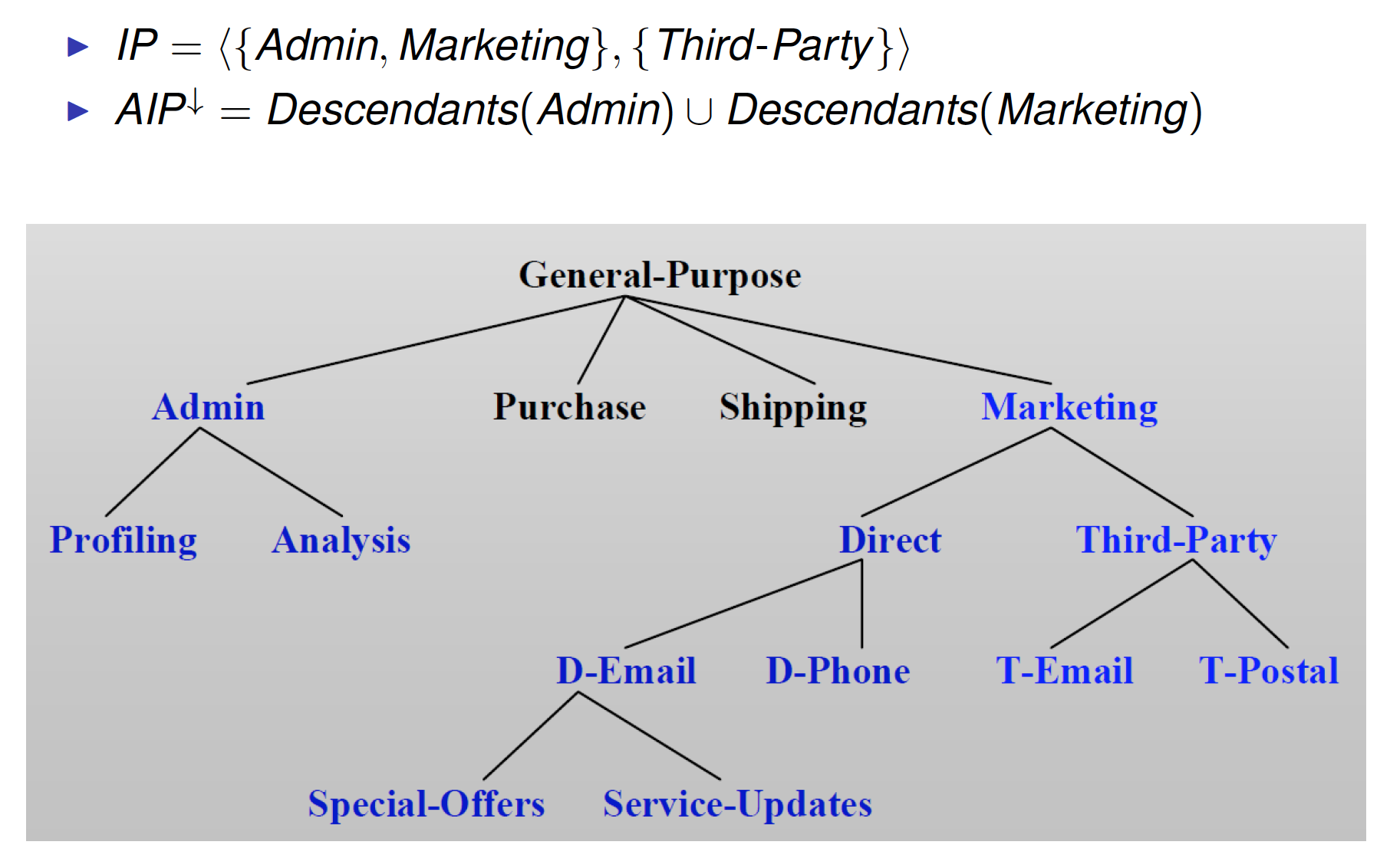
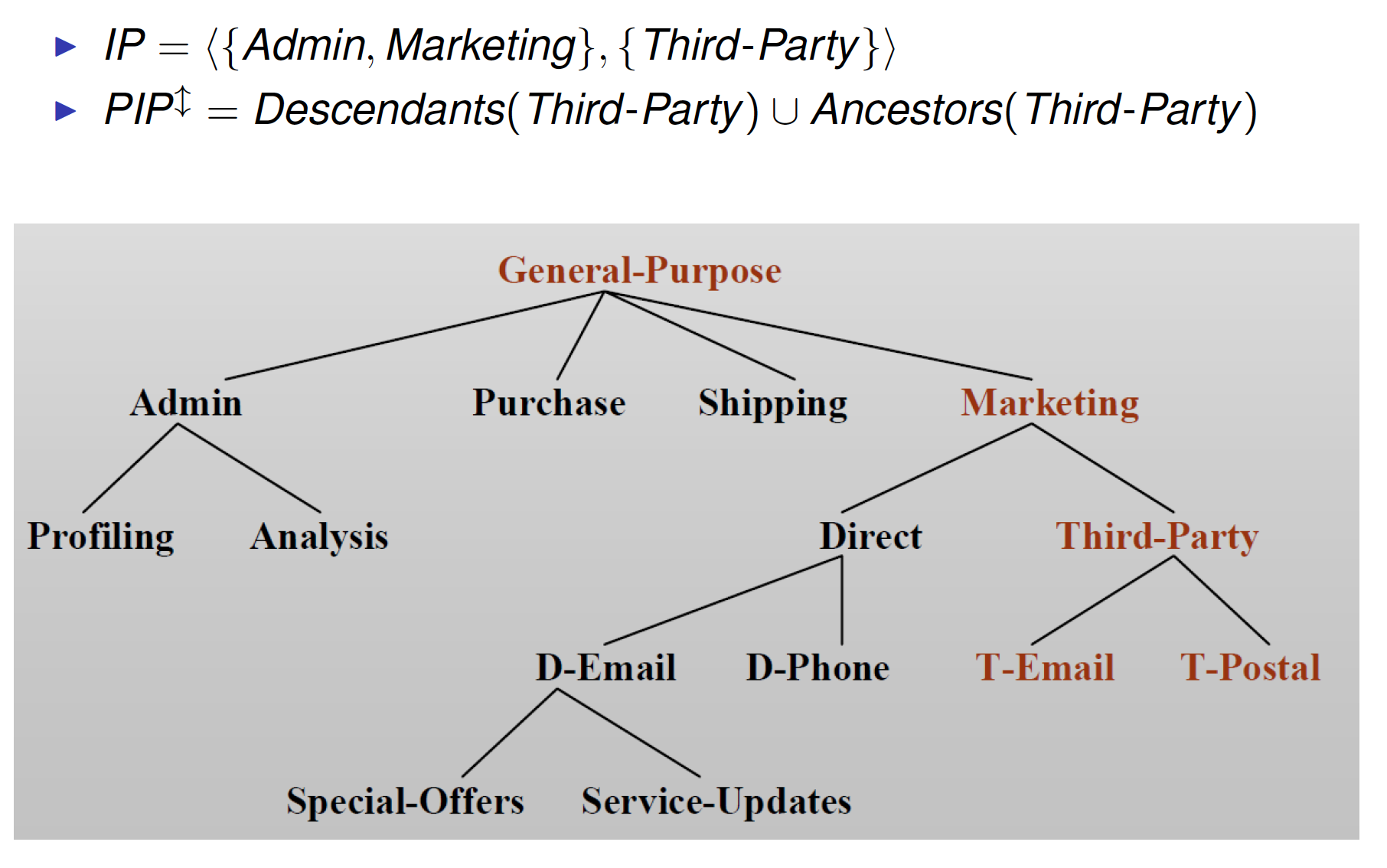
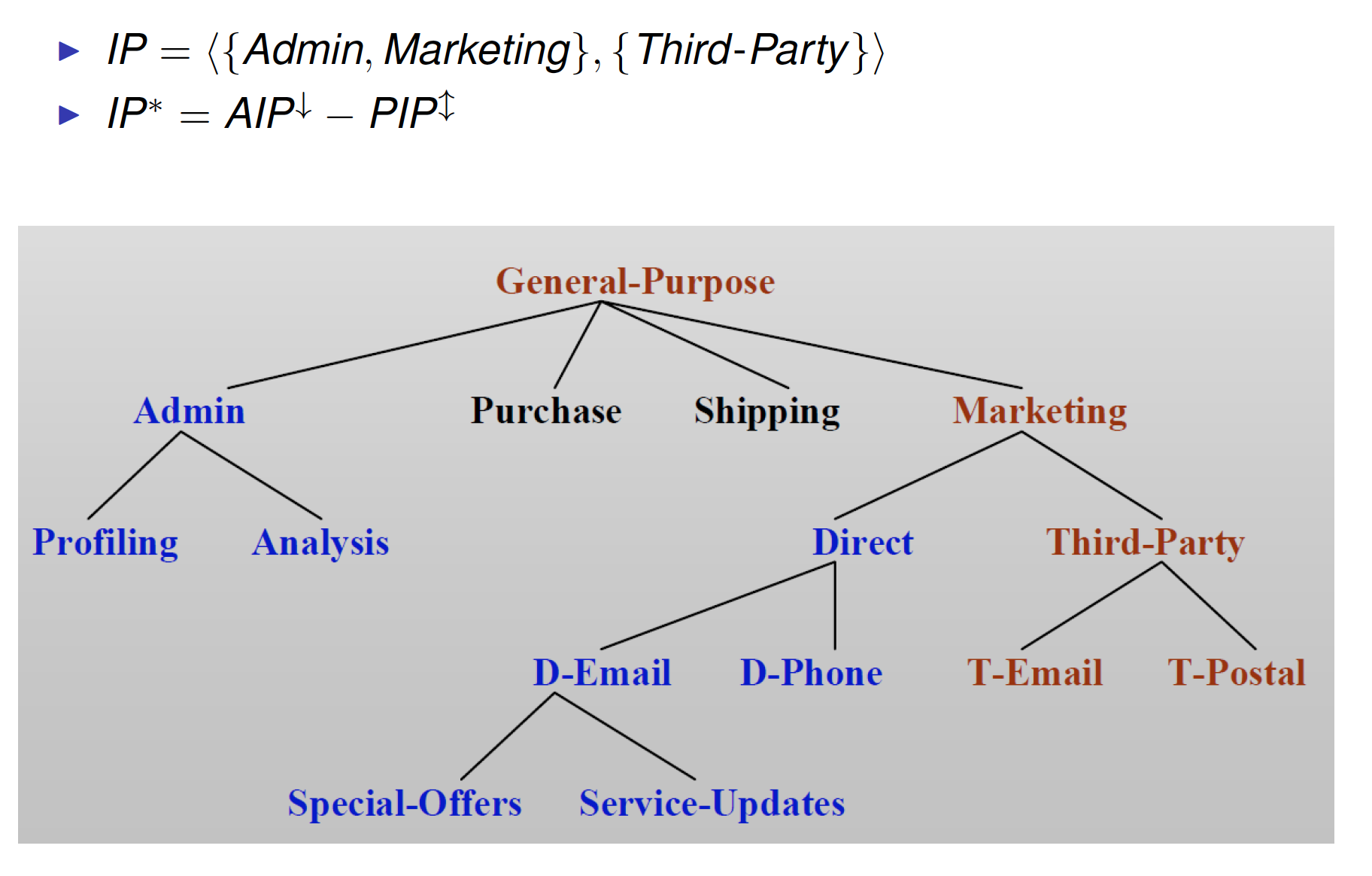
Purpose Compliance
Intended purposes tell how data should be used
Access purpose tells how data will be used
Purpose Compliance:

Exercise
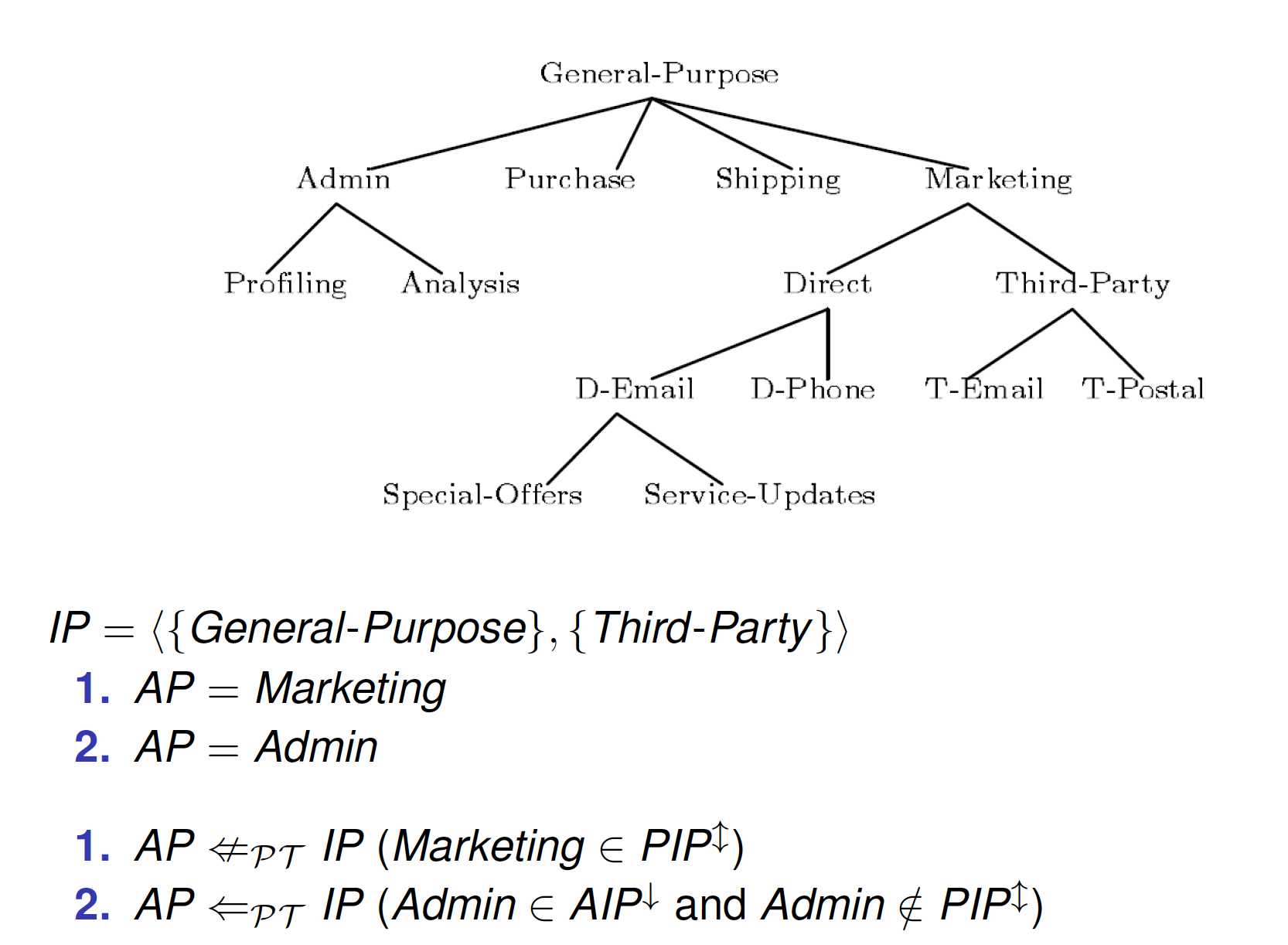
Access Purpose Determination
Access Purpose – Definition
Access Purpose
- Purpose for accessing a particular data item
- Associated with each data request (i.e., query)
- e.g. SELECT name FROM customer FOR Marketing
How do we determine access purposes?
- That is, how does the access control system determine with what purpose a particular user is trying to access a particular data item?
Access Purpose Determination
Users explicitly state their access purposes in access request
- Need to trust the users
Register every application or procedure with an access purpose
- Not applicable if they are complex
Dynamically determined from the current context of the systemI
- Difficult to capture all possibilities
Access Purpose Verification
Users explicitly state the access purpose when querying
- e.g., SELECT name FROM customer FOR Marketing
Then, the system verifies if the stated access purpose is valid
- i.e., the system checks if the user is indeed allowed to access data with the stated purpose for a given circumstances
Verification done through roles (RBAC model)
Role Attributes
Roles organized in hierarchies
Role attributes
- Every role r is associated with a set of attributes
- Defined directly for r
- inherited from the ancestor roles of r
- When a user is assigned to a role r , the values for the role attributes of r are specified for the user
Values of role attributes available to access control system

System Attributes
Characterize the environment of the system
Defined by system administrators for the application needs
Available to access control system at all times
Conditional Roles
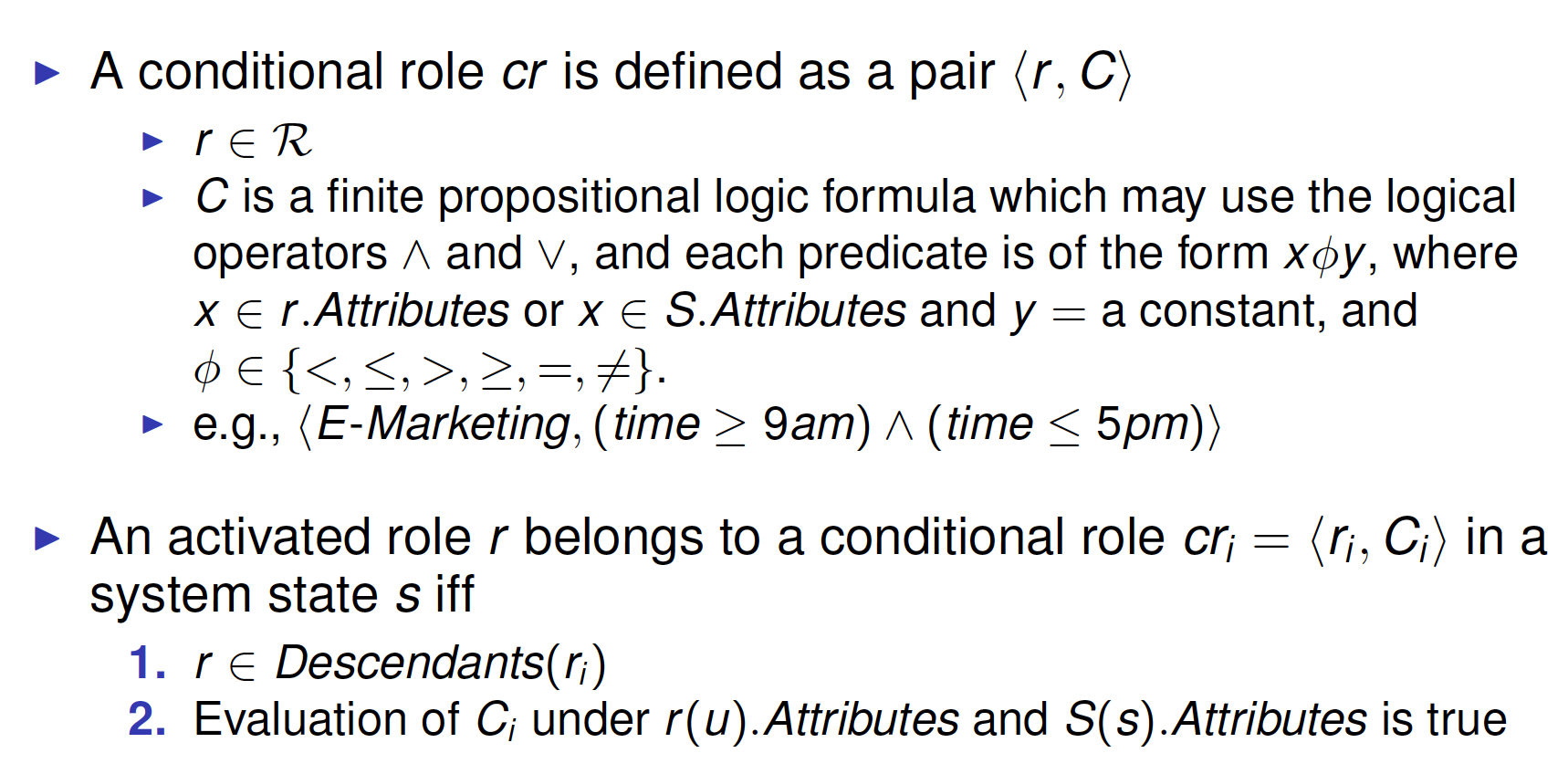
Access Purpose Verification
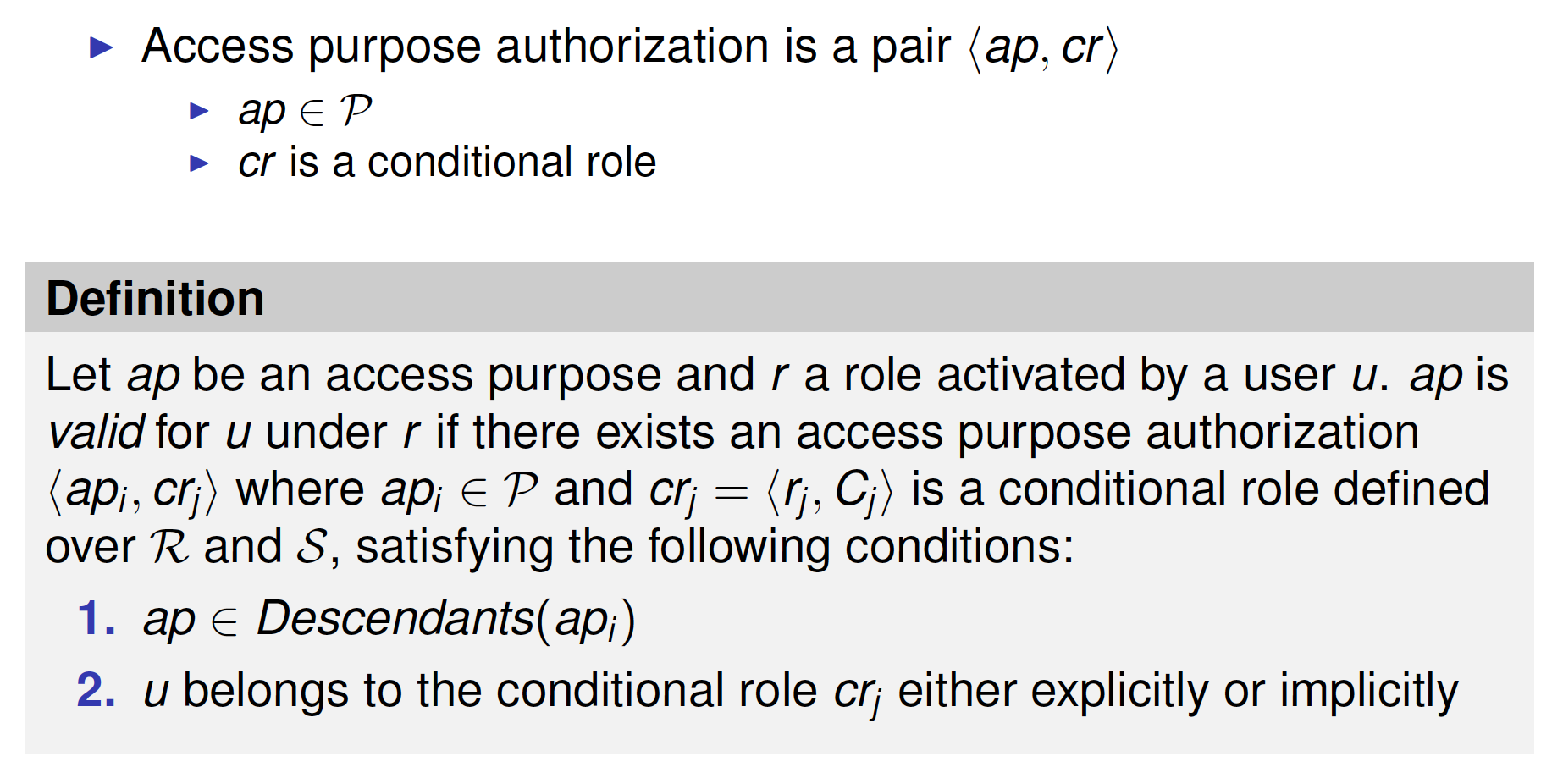
Access Decision
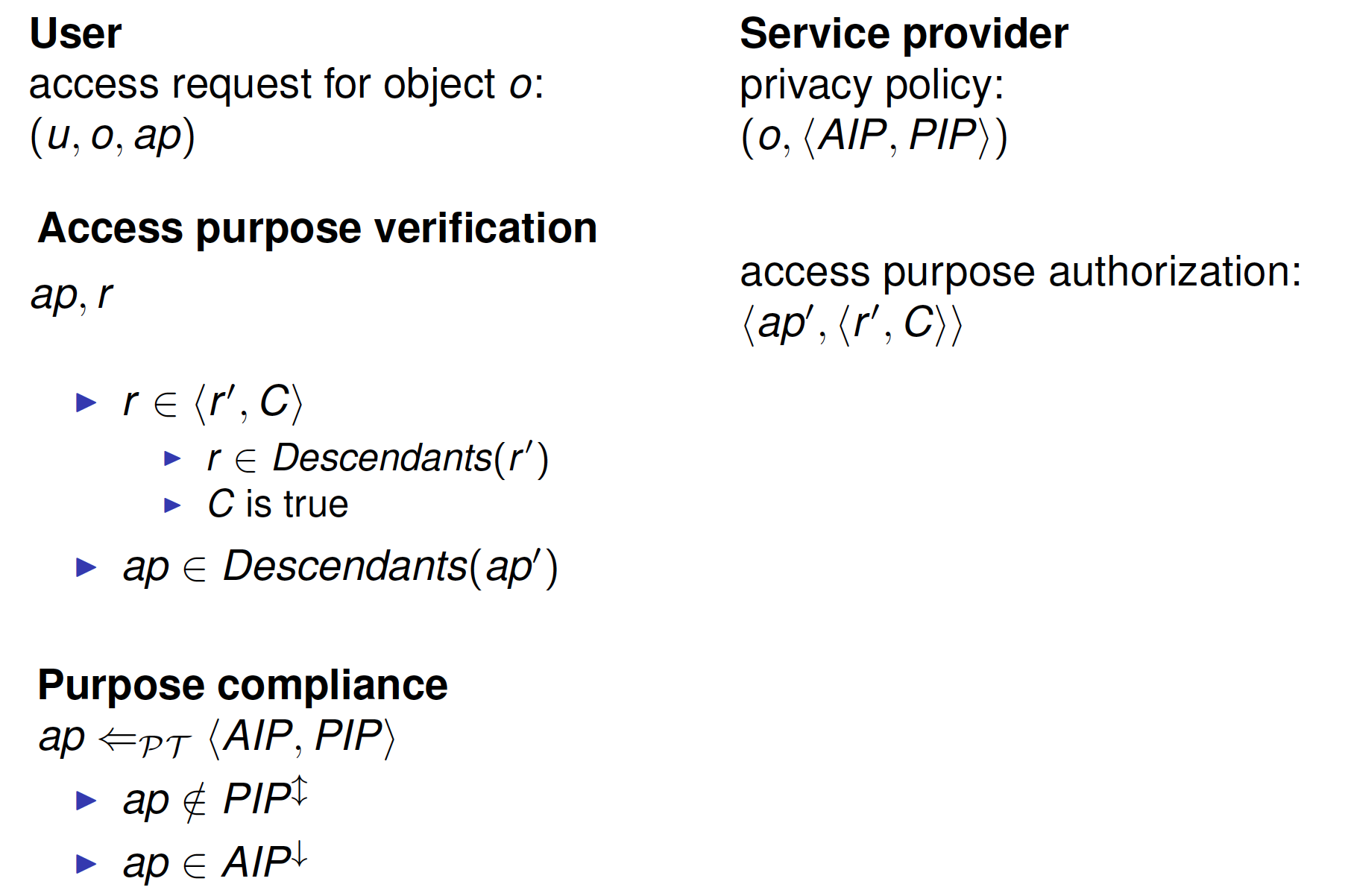
Exercise
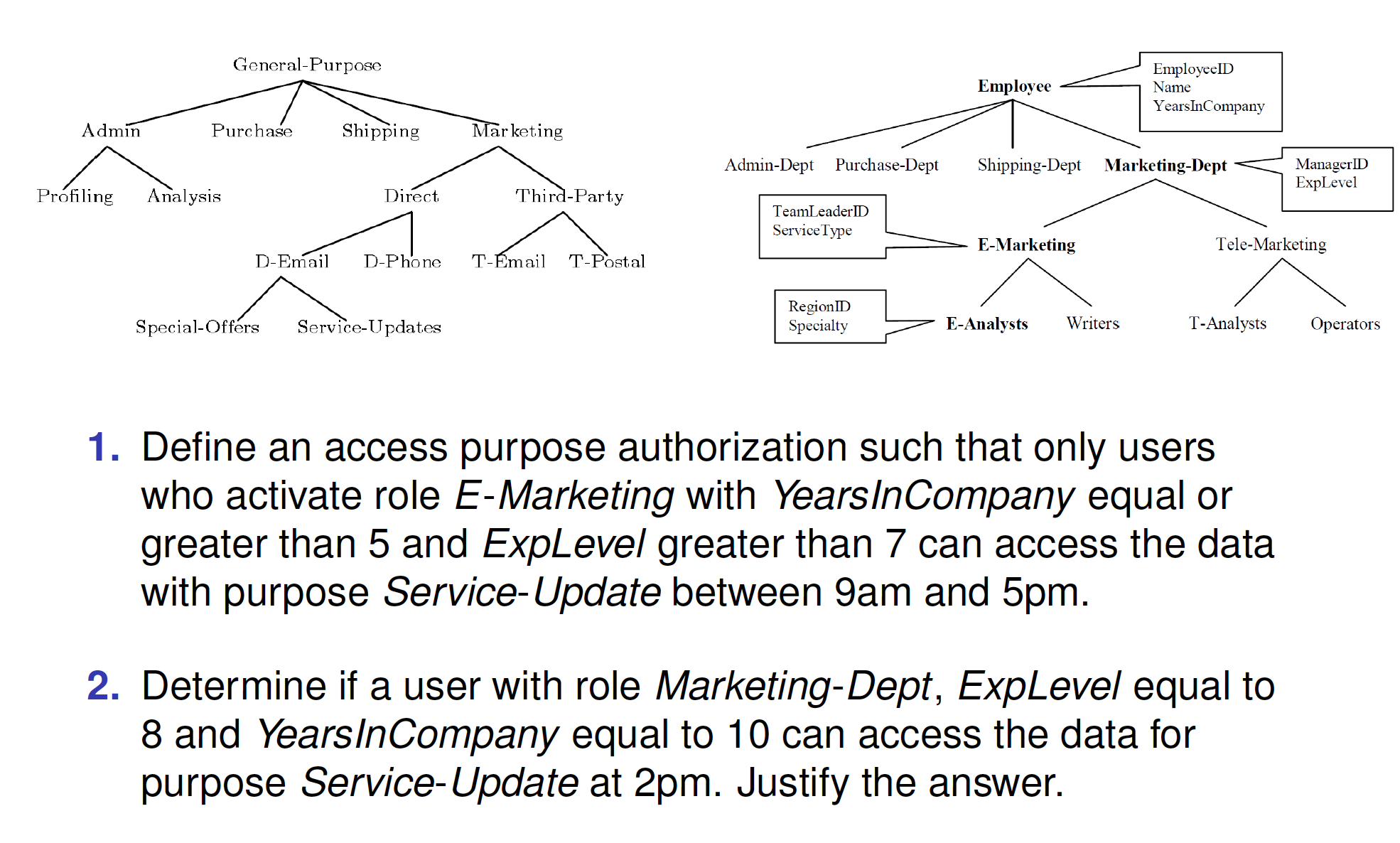
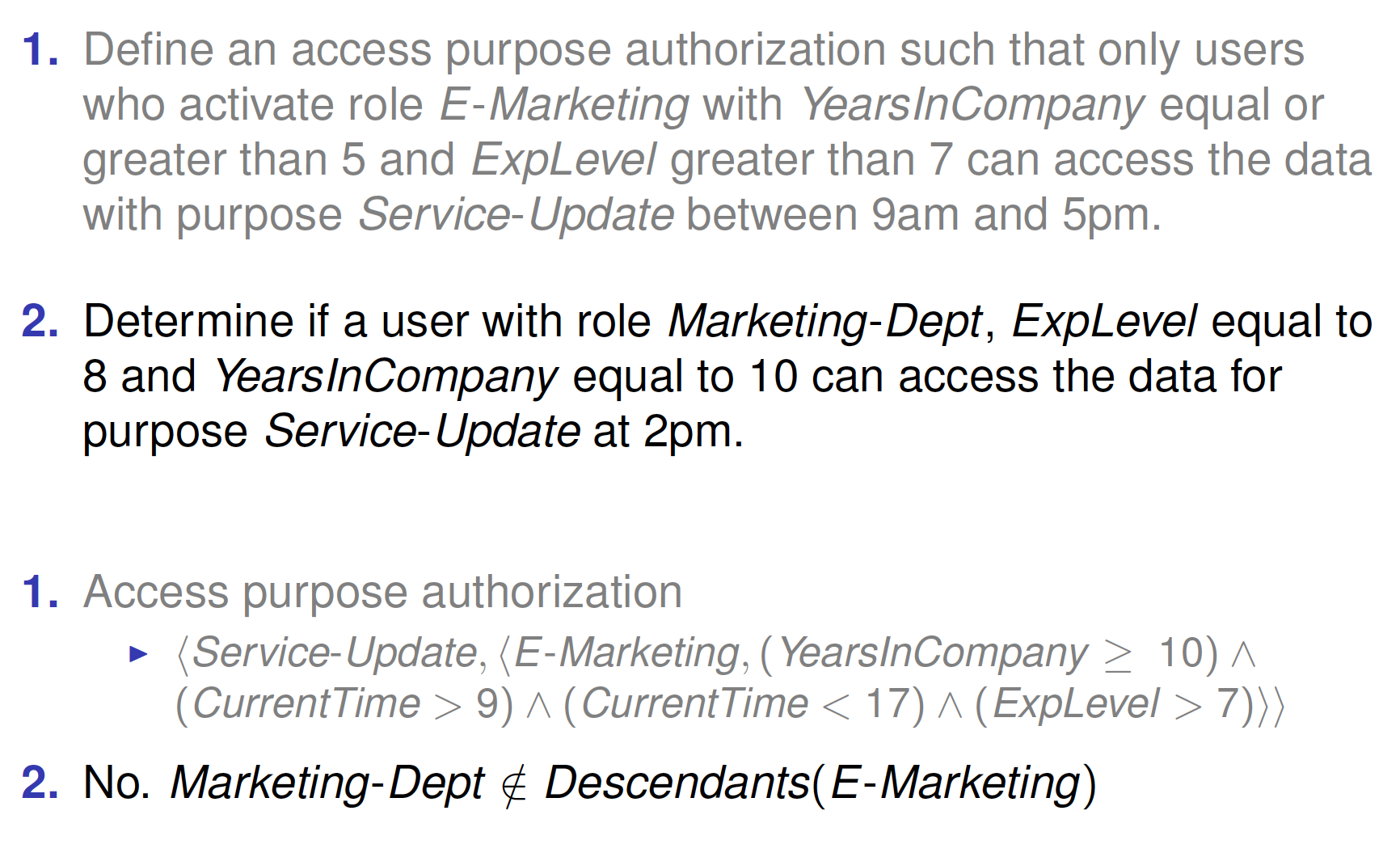
Summary
Access control vs. Privacy
- Protect information from unauthorized access
- No control on how and why information is used
Privacy-aware access control
- Extend access control with the notion of purpose
Hippocratic Databases
- Metadata for the specification of privacy policy and privacy authorization tables
- No purpose managementI
Purpose-based access control
- Purpose management
- Access purpose determination
- No purpose control
Reference
Rakesh Agrawal, Jerry Kiernan, Ramakrishnan Srikant, YirongXu: Hippocratic Databases. VLDB 2002: 143-154 (obligatory)
Ji-Won Byun and Ninghui Li. 2008. Purpose based accesscontrol for privacy protection in relational database systems. TheVLDB Journal 17(4):603-619. 2008. (obligatory)
谈数据库的安全技术. http://www.qb5200.com/content/2016-01-12/117856.html